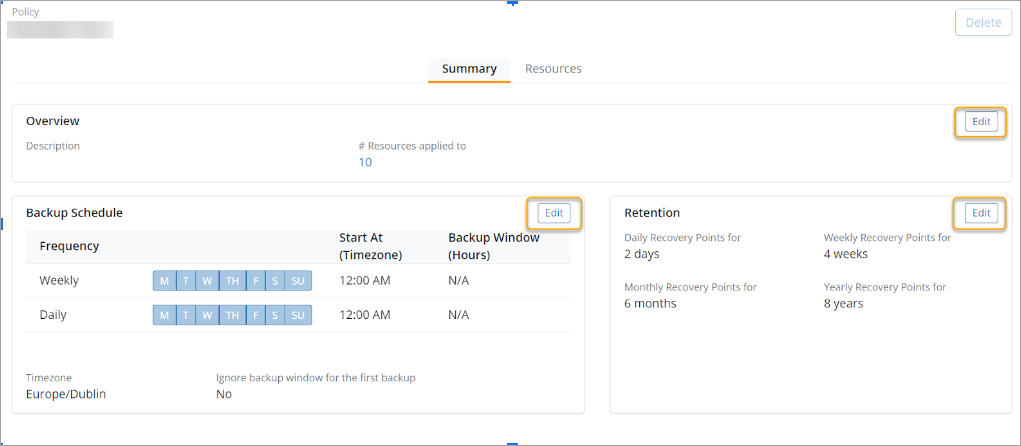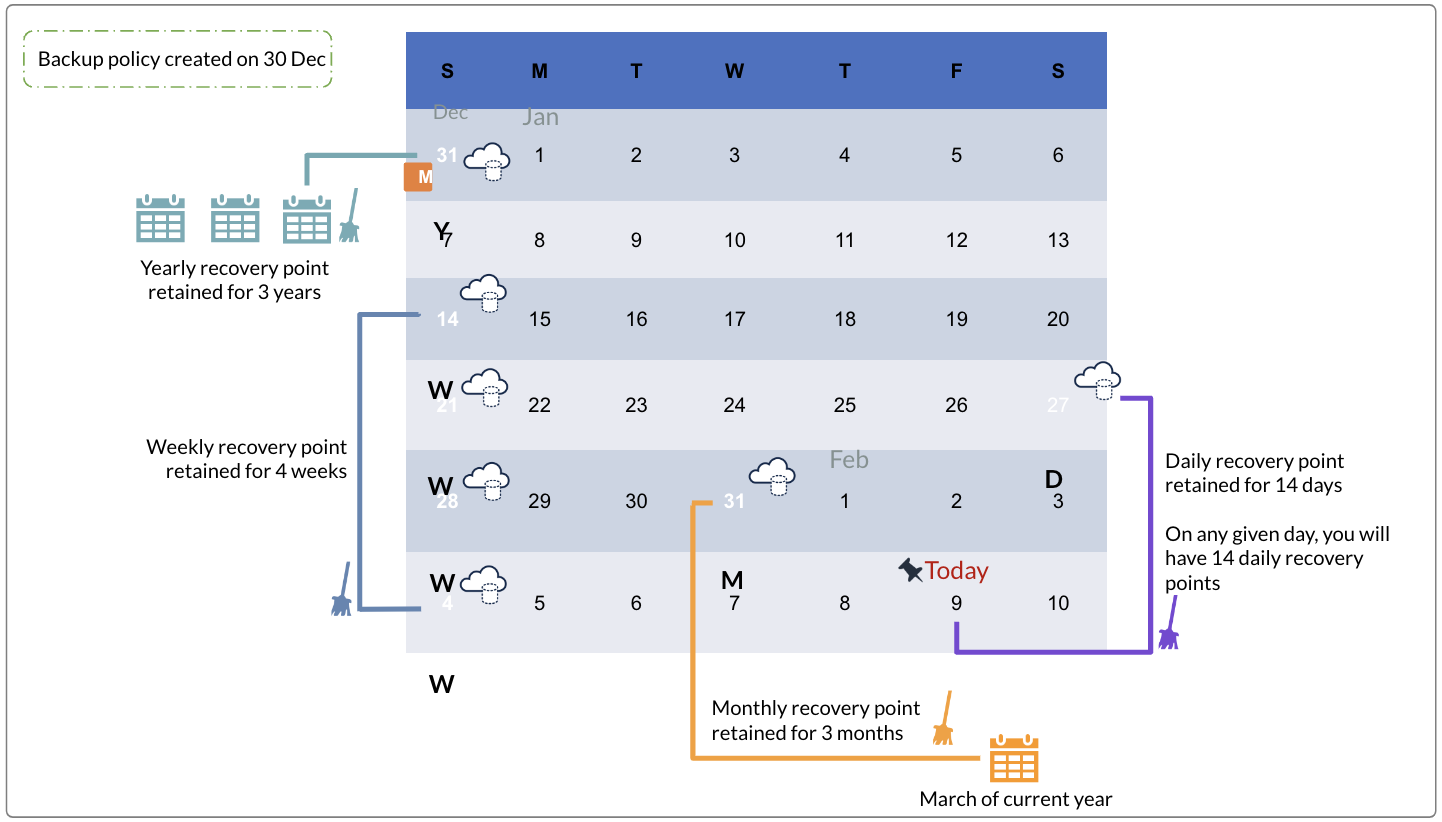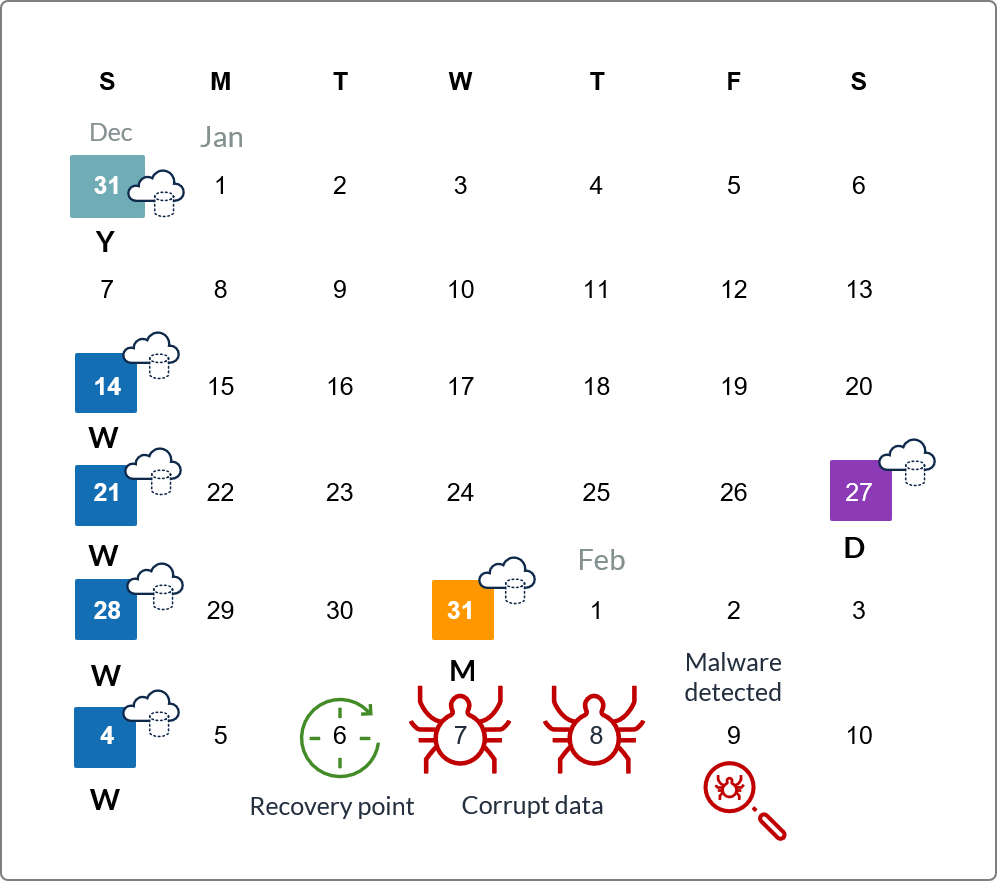Configure backup settings
 Business
Business  Enterprise
Enterprise  Elite
Elite You can either manually configure virtual machines for backup or create autoconfig rules for automatically configuring virtual machines for backup. For more information about how the backups are taken, see Azure VM backup workflow.
The following sections provide details of manual and automatic configuration of virtual machines for backup.
Get started with configuring for backup
To protect your virtual machines, you must first set up your virtual machines for backup.
As a part of the configuration, you must do the following:
-
Create and/or assign a backup policy
-
Add or edit backup settings
-
Add or edit retention settings
-
Add or manage resource tags
About backup policy
Backup policies are rules that define a schedule, bandwidth for scheduled backups, and retention period for recovery points. By defining backup policies, you can define the rules for backing up Azure virtual machines.
A backup policy defines the following:
-
When a backup job is triggered.
-
The bandwidth available for the agent to execute a backup job.
-
The backup frequency to back up archive logs.
-
The period for which a recovery point is retained.
Druva provides a default backup policy. You can use this default backup policy or create a new one. Druva backs up the virtual machines based on the backup schedule defined in a backup policy.
Considerations
-
You can attach the same backup policy to different virtual machines.
-
The backup policy defines the backup schedules for your virtual machines. The schedules that you set depends on the volume and frequency of changes. If you expect a large chunk of data for backup, you can schedule backups to run during off-peak hours, such as weekends or after a workday.
-
You can delete a backup policy only when there is no auto-configuration rule associated with it.
Create backup policy
You can create a backup policy using three easy steps as shown in the following diagram:

| No. | Step | Action |
|---|---|---|
| 1. | Backup Policy Overview | Provide a description for the backup policy. For more information, see Step 1: Provide Backup Policy Overview. |
| 2. | Backup Schedule | Provide the schedule at which you want to run your backups. For more information, Step 2: Provide Backup Schedule. |
| 3. | Backup Retention | Provide retention settings for your backups. For more information, see Step 3: Provide Backup Retention Settings |
Step 1: Provide Backup Policy Overview
-
Log in to the Management Console.
-
On the console, from the top menu, select Organization.
-
Select Protect > Azure Workloads > Virtual Machines.
-
In the left navigation pane, click Backup Policies.
-
On the Back Policies listing page, click New Backup Policy.
-
On the New Backup Policy > Overview tab, enter the policy name and description and click Next.
Step 2: Provide Backup Schedule
You can either retain the default schedule or add your own schedule to back up virtual machines. You can add more than one schedule to backup your virtual machines. To add a new schedule:
-
On the New Backup Policy > Schedule tab, click Add Schedule.
-
Provide the following details and click Next:
| Field | Description |
|---|---|
| Backup Frequency | Select the days on which the automatic backups should occur at the specified time. You can schedule the frequency as daily, or weekly. |
| Start at | Select the off-peak time, in a 12-hour format, when you want backups to start. Backup operations follow the time zone that you specify. |
| Backup Window | Set the duration for how long the backup should run. Type the number of hours. Example If you set Start at to 01:00 AM and you set the duration to 6 hours, backups from your server start at 01:00 AM and stop at 07:00 AM, even if they do not complete. |
| Ignore backup window for first backup | The Ignore backup window for the first backup option is enabled by default. When this option is enabled, it ignores the specified backup duration until the first backup job is complete. The first backup job is complete when the first recovery point is created. You can disable this option to enforce backup duration for the first backup job. |
| Time Zone | The time zone in which the scheduled backup will run. |
Step 3: Provide Backup Retention Settings
You can retain the default retention settings or provide custom values to determine the duration for which you want to retain your backups.
On the New Backup Policy > Retention tab, provide the following details and click Finish:
| Field | Description |
|---|---|
| Daily Recovery points for | Specify the number of days, for which you want to retain all the daily recovery points. The default value is 14. |
| Weekly Recovery points for | Specify the number of weeks for which you want to retain the latest weekly recovery point. The default value is 4. |
| Monthly Recovery points for | Specify the number of months for which you want to retain the latest monthly recovery point. The default value is 3. |
| Yearly Recovery points for | Specify the number of years, for which you want to retain the latest yearly recovery point. The default value is 3. |
Edit a backup policy 
You can edit an existing backup policy. When you change the backup policy settings, then from that time onwards, the backups will be taken as per the new schedule and retention settings. You can edit the following information in a backup policy:
-
Overview
-
Backup schedule
-
Retention settings
Procedure
-
Log in to the Management Console.
-
On the console, from the top menu, select Organization.
-
Select Protect > Azure Workloads > Virtual Machines.
-
In the left navigation pane, click Backup Policies.
-
On the Back Policies listing page, click the backup policy that you want to edit.
-
To edit the backup policy, on the Summary tab, click the Edit button of the section that you want to edit, such as Overview, Backup Schedule, and Retention, as shown in the following screenshot:

-
Make the required changes and click Save.
About Retention
Retention defines the rules for retaining your backups (recovery point) within the storage. Use the retention period to define the duration for which you want to retain your historical backups.
The objective of retention is to keep important data for future access, depending on how critical it is. Retention also ensures that backups that are no longer required are cleaned from your storage periodically, resulting in less storage utilization and costs.
Note: The retention period would not be honored for the most recent recovery point when a VM or backup set is disabled. This allows you to restore the latest recovery point later if required.
Retention should consider the value of your data and the compliance requirements. The different types of data will be retained for different durations. For example, a bank's retention period for customers' financial records is different from facilities inventory records.
The main factors to consider while defining a retention period are:
-
Compliance requirements
-
Storage costs
-
Type of data
Retention period settings
Druva follows the Grandfather-Father-Son (GFS) retention model wherein, in case of an overlap, the retention setting of the longer period (Son-Father-Grandfather relation) is considered. The recovery point is expired as per the settings of the higher period. For example, in case there is an overlap between the daily and weekly retention period, the weekly retention period is considered. So daily is the smallest unit and weekly overrides daily > monthly overrides weekly > yearly overrides monthly.
Also, Druva follows the Gregorian calendar for tracking days.
While backup schedules are configured on an hourly, daily, or weekly basis the last recovery point created by the backups on that particular day will be retained as per the retention setting.
You can define the following durations to retain recovery points.
| Retention Period | Description |
|---|---|
| Daily recovery points | Druva retains all the recovery points that are created for the number of days specified in Daily recovery points.
Druva considers midnight as the end of a day. If you have configured Druva to back up your server multiple times within a day, Druva retains all the recovery points for the days specified. |
| Weekly recovery points (Son) | The number of weekly recovery points that Druva should retain. Druva treats the latest recovery point in the week as the weekly recovery point.
Druva considers midnight on Sunday as the end of the week. |
| Monthly recovery points (Father) | The number of monthly recovery points that Druva should retain. Druva treats the latest recovery point in the month as the monthly recovery point.
Druva considers midnight of the last day of a month as the end of the month. |
| Yearly recovery points (Grandfather) | The number of yearly recovery points that Druva should retain. Druva treats the latest recovery point in the year as the yearly recovery point. Druva considers the midnight of the last day of the year as the end of the year. |
The recovery point name displayed on the Management Console is recovery point creation time as per the server time zone, on which the backup occurred. Druva considers the time zone of the server for retaining the recovery points as per the retention setting.
Default retention period settings
If you are registering the server under default organization, Druva provides a default backup policy with the following retention settings:
-
Daily recovery points: 14 days
-
Weekly revisions: 4 weeks
-
Monthly revisions: 3 months
-
Yearly revisions: 3 years
Example
The following diagram illustrates the recovery points that will be available on a given day ( Feb 9 in this example) based on the retention settings you have configured. In this example the policy is created and backups start on Dec 30 of the previous year.

On 9 Feb you will have 17 recovery points or recovery points to restore as described in the table.
Note: Daily is the smallest unit and weekly overrides daily and monthly overrides weekly and yearly overrides monthly.
| Recovery points resulting from | Description |
|---|---|
| Daily retention setting | You will have 11 ( 14 daily less 2 weekly less 1 monthly) recovery points (starting from 27 Jan) created due to the daily retention settings. |
| Weekly retention setting | You will have 11 ( 14 daily less 2 weekly less 1 monthly) recovery points (starting from 27 Jan) created due to the daily retention settings. The weekly recovery points that coincide with the daily recovery points (28 Jan and 4 Feb) will be considered and retained as per the weekly setting. So, even though the daily retention period expires for these dates the recovery points will be retained as per the weekly settings (4 weeks). |
| Monthly retention setting | You will have 1 monthly recovery point of 31 Jan. This recovery point will be available for the next 3 months as it is a monthly retention point. So even though the 14 days daily retention period expires after 9 Feb, the recovery point will be available for the next 3 months. |
| Yearly retention setting | You will have one recovery point for 31 Dec due to the yearly retention setting. This recovery point will be available for 3 years. |
Impact of retention period settings on recovery point objective (RPO)
In continuation with the example above, so let us say malware was detected on 9 Feb evening. After investigation, it was discovered that the data till 7 Feb is corrupted. In that case, the recovery point available to you will be of 6 Feb which is available due to the daily recovery point. However, there could be a data loss of data backed between 7 Feb and 9 Feb.

Considerations
-
Any changes that you make to the existing retention policies will be applied to all the new as well as the existing recovery points.
-
Retention periods are applicable for recovery points that reside on CloudCache and Cloud.
-
Druva runs a retention expiration algorithm to delete the recovery points that have crossed the expiration period. This algorithm does not delete thawed recovery points. For more information, see Recovery points.

